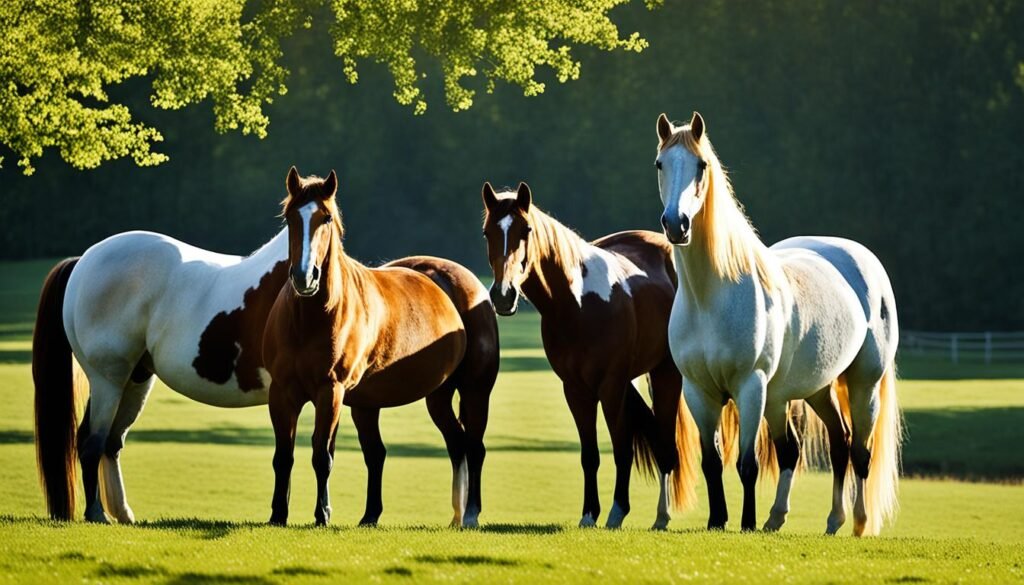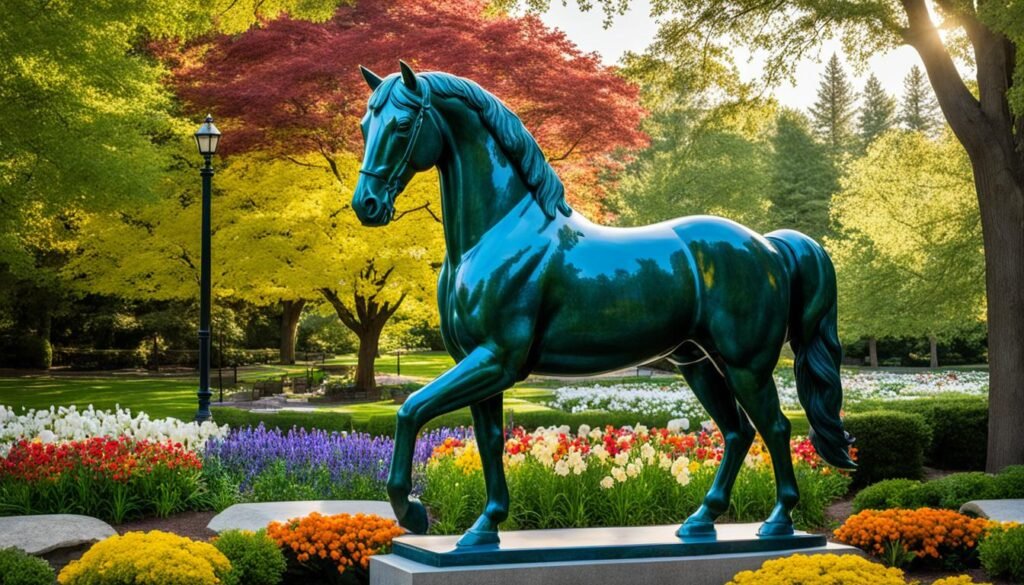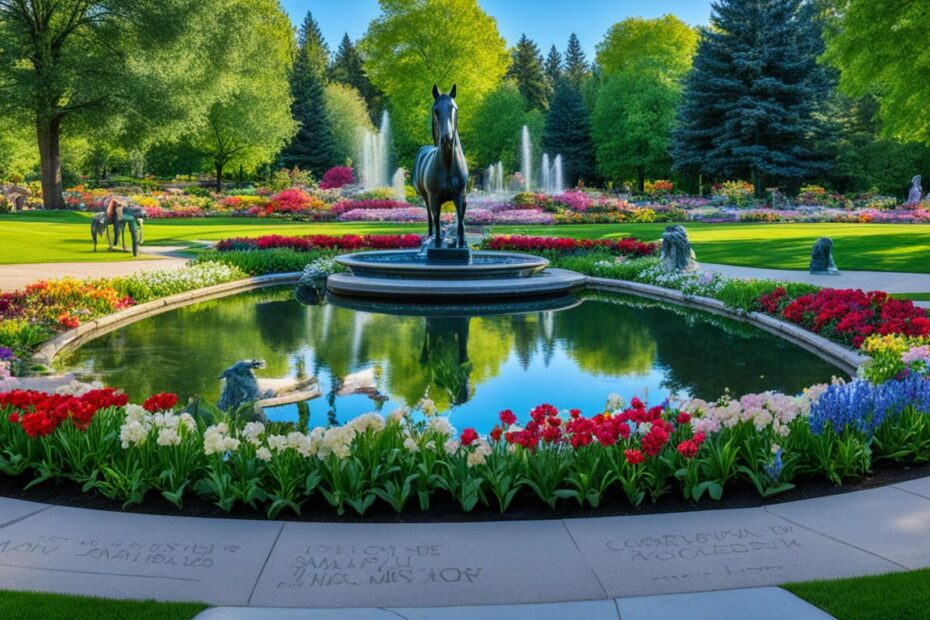In a heartwarming and collaborative effort, communities across the nation are coming together to create Equine Memory Gardens – public spaces dedicated to honoring and memorializing the beloved horses that have enriched our lives.
These sanctuaries, funded through the power of crowdsourcing, provide a serene and respectful resting place for our equine companions, ensuring their legacies live on in the hearts and minds of those who cherish them.
The establishment of Equine Memory Gardens is a testament to the profound bond between humans and horses, a bond that transcends mere ownership or utility. Horses have long been revered as loyal companions, trustworthy partners, and majestic creatures that have shaped our history and culture.
When these magnificent animals pass on, the need for a sacred and dignified place to grieve and commemorate their memory becomes paramount.
Through the power of crowdsourcing, communities are coming together to create these hallowed spaces, where families, equestrian enthusiasts, and the general public can gather to honor the memory of their beloved equine friends.
By pooling their resources and collective compassion, these grassroots efforts have given rise to a network of Equine Memory Gardens that serve as beacons of hope and healing for horse lovers everywhere.
Key Takeaways
- Equine Memory Gardens are public spaces created to honor and memorialize fallen horses through crowdsourcing efforts.
- These sanctuaries provide a serene and respectful resting place for equine companions, ensuring their legacies live on.
- The establishment of Equine Memory Gardens is a testament to the profound bond between humans and horses.
- Crowdsourcing enables communities to come together and create these meaningful spaces, where horse lovers can gather to grieve and commemorate their equine friends.
- Equine Memory Gardens serve as beacons of hope and healing for the equestrian community.
Introduction to Equine Memory Gardens
Equine Memory Gardens are dedicated public spaces that honor and memorialize beloved horses who have passed away.
As horses hold a cherished place in the hearts of many, there is a growing need for respectful and accessible equestrian farewell spaces where owners, equestrians, and communities can pay tribute to their equine companions.
What are Equine Memory Gardens?
Equine Memory Gardens are animal memorial parks designed specifically for the interment and memorialization of horses. These thoughtfully crafted spaces provide a serene and dignified setting for horse owners to lay their equine friends to rest.
From individual grave markers to communal memorials, Equine Memory Gardens offer a variety of options to commemorate the lives of these majestic animals.
The Need for Respectful Horse Burial Spaces
Traditionally, horse owners have faced limited options when it comes to honoring their fallen equines. Some have resorted to private burial on their own land, while others have had to rely on commercial pet cemeteries that may not fully capture the unique bond between humans and horses.
Equine Memory Gardens address this need by providing specialized, dignified, and accessible spaces where the equine community can gather to remember and celebrate the lives of their beloved horses.
By establishing Equine Memory Gardens in public areas, these cherished equine companions can be honored and memorialized in a manner that reflects their significant role in our lives and communities.
These dedicated spaces serve as a place of solace, reflection, and shared remembrance for all who have been touched by the special connection with horses.
Crowdsourcing: A Collaborative Approach
Equine Memory Gardens are often funded through crowdsourcing, a collaborative approach that allows communities to come together and contribute resources to create these meaningful spaces.
Crowdsourcing enables the public to support the establishment and maintenance of community-supported equine resting places, crowdfunded pet graveyards, and group-funded equine memorials.
By tapping into the generosity and passion of horse enthusiasts, animal lovers, and members of the local community, collaborative horse cemetery funding initiatives can bring these special equine memorials to life.
Crowdsourcing platforms provide a structured way for people to donate, share, and raise funds for the creation and upkeep of Equine Memory Gardens.
These group-funded equine memorials serve as sacred spaces where individuals and families can honor the memory of beloved horses. Through this collective approach, Equine Memory Gardens become cherished community assets that reflect the deep bond between humans and their equine companions.
| Crowdsourcing Benefits | Crowdsourcing Challenges |
|---|---|
| Engages the community Generates broader awareness and support Enables shared ownership and investment Allows for sustainable funding | Requires ongoing promotion and outreach Needs a clear vision and project plan Faces potential challenges in reaching fundraising goals Requires dedicated team to manage the campaign |
By embracing a collaborative approach through crowdsourcing, Equine Memory Gardens become a true reflection of the community’s commitment to honoring the legacy of its beloved horses.
The Emotional Connection with Horses
Horses have long held a special place in the hearts and lives of their human companions. These majestic creatures are more than just animals; they are partners, friends, and sources of joy and comfort. The bond between humans and equines is deeply rooted in our shared history, as horses have played a vital role in our personal and cultural experiences.
Horses as Companions and Partners
Horses are often considered loyal companions, offering unwavering support and a calming presence to their human caretakers.
Through activities like horseback riding, grooming, and simply spending time together, people form strong emotional connections with their equine friends. These bonds can be particularly meaningful for individuals seeking emotional support, therapeutic benefits, or a deeper connection with the natural world.
The Bond Between Humans and Equines
- Horses have a unique ability to sense and respond to human emotions, creating a profound sense of understanding and trust.
- The companionship of horses can provide a sense of purpose, responsibility, and personal growth for their human partners.
- The loss of a beloved horse can be deeply felt, leading to a desire for respectful spaces to honor their memory and celebrate the impact they had on our lives.
The emotional connection between humans and horses has fueled a growing demand for equestrian farewell spaces, where people can gather to commemorate the lives of their equine companions.
These spaces, often known as Equine Memory Gardens, offer a meaningful way to celebrate the special bond we share with these remarkable animals.

Equine Memory Gardens Funded by Crowdsourcing
Equine Memory Gardens, peaceful resting places for beloved horses, are increasingly being funded through the collaborative approach of crowdsourcing.
This innovative funding model empowers communities to contribute resources and support the establishment of these meaningful equine memorial spaces.
How Crowdsourcing Works for Equine Memory Gardens
Crowdsourcing allows the public to actively participate in the creation and maintenance of equine memorial parks. Through online fundraising platforms, individuals and local equestrian groups can pool their resources to finance the development and upkeep of these sacred sites.
The collaborative nature of crowdfunding fosters a sense of shared responsibility and community ownership over these spaces that honor fallen horses.
Benefits of Crowdsourced Funding
- Engages the local community in the preservation of equine heritage
- Reduces the financial burden on individual horse owners or organizations
- Encourages widespread participation and a sense of collective stewardship
- Enables the creation of more equine memorial gardens across diverse regions
- Promotes public awareness and appreciation for the bond between humans and horses
The crowdsourced funding model for Equine Memory Gardens empowers communities to come together and honor the memory of their equine companions.
By leveraging the power of collaborative efforts, these peaceful resting places for horses can be established and maintained with the support of the public.
Designing Equine Memory Gardens
Equine Memory Gardens are thoughtfully designed to honor the memories of our beloved equine companions. These serene spaces often incorporate equestrian-themed elements and symbolic representations that reflect the grace, strength, and beauty of horses.
From majestic statues to carefully curated landscaping, every aspect of the garden’s design is intended to create a peaceful and meaningful environment for remembrance and reflection.
Incorporating Equestrian Themes and Symbolism
The design of Equine Memory Gardens can include a variety of equestrian-inspired features that pay tribute to the unique bond between humans and horses. Common elements may include:
- Bronze or stone statues of horses, showcasing their power, elegance, and gentle spirit
- Winding pathways that mimic the meandering of horses in a pasture
- Ornamental fencing or gates that evoke the look and feel of a traditional stable or corral
- Carefully selected plant life, such as flowering bushes or trees, that echo the natural environments where horses thrive
- Benches or seating areas designed with equestrian motifs, providing a space for quiet contemplation
These thoughtful design choices help to create a serene and meaningful setting where visitors can honor the memory of their equine companions, surrounded by the symbols and imagery that celebrate the unique spirit of these magnificent animals.
| Design Element | Purpose |
|---|---|
| Equestrian Statues | Highlight the grace, strength, and beauty of horses |
| Winding Pathways | Emulate the natural movement of horses in a pasture |
| Ornamental Fencing | Evoke the look and feel of a traditional stable or corral |
| Carefully Selected Plants | Echo the natural environments where horses thrive |
| Equestrian-Themed Seating | Provide a space for quiet contemplation and remembrance |
Honoring Fallen Horses in Public Spaces
Public equine remembrance gardens provide a meaningful way for communities to come together and pay tribute to their beloved equines.
These serene spaces offer a place of solace and reflection, allowing horse owners and the general public to commemorate the lives of the horses that have left an indelible mark on their lives and local equestrian culture.
These gardens often feature thoughtful memorials, such as plaques, statues, or engraved stones, that honor the memory of individual horses. Visitors can take solace in the peaceful ambiance, surrounded by lush greenery and equestrian-inspired elements that create a fitting environment to remember their equine companions.
Beyond serving as a place of remembrance, public equine remembrance gardens also play a vital role in fostering a sense of community.
They provide a shared space where horse enthusiasts and the general public can gather to celebrate the enduring legacy of these majestic animals, strengthening the bond between humans and equines.

By establishing these public equine remembrance gardens, communities can ensure that the memory of their fallen horses lives on, inspiring future generations to cherish the profound impact these animals have had on our lives and society.
Community Involvement and Engagement
The creation and maintenance of community-supported equine resting places, known as Equine Memory Gardens, often involve the active participation and engagement of the local community, including equestrian clubs and organizations.
These groups play a crucial role in organizing fundraising efforts, volunteering, and ensuring the long-term sustainability and care of the gardens.
The Role of Local Equestrian Clubs and Organizations
Equestrian clubs and organizations are the backbone of the Equine Memory Garden movement. They serve as the driving force behind these meaningful projects, leveraging their deep connections within the horse community.
From spearheading awareness campaigns to coordinating volunteer work parties, these passionate groups ensure that the gardens become cherished spaces that honor the legacy of beloved equines.
Local equestrian clubs and organizations often take the lead in establishing Equine Memory Gardens within their communities. They work tirelessly to secure the necessary funding through creative crowdsourcing initiatives, engaging both equine enthusiasts and the general public.
By fostering a sense of ownership and pride, these groups cultivate a strong community bond around the gardens, ensuring their long-term preservation and care.
Furthermore, equestrian clubs and organizations play a vital role in maintaining the Equine Memory Gardens. Their members volunteer their time and expertise to tend to the gardens, ensuring that they remain a serene and respectful tribute to the horses that have touched so many lives.
This hands-on involvement not only preserves the gardens but also strengthens the connection between the community and these meaningful spaces.
Through the collective efforts of the local equestrian community, Equine Memory Gardens have become a powerful symbol of the deep bond between humans and horses.
These community-supported spaces serve as a testament to the enduring legacy of equines, providing a place for reflection, healing, and celebration of their invaluable contributions to our lives.
Legal and Regulatory Considerations
When establishing pet cemeteries or horse burial grounds, navigating the complex web of legal and regulatory considerations is crucial.
The successful implementation of Equine Memory Gardens often requires close collaboration with local authorities and adherence to a range of relevant policies and guidelines.
One of the primary considerations is obtaining the necessary permits to operate a pet cemetery or horse burial ground within a specific jurisdiction. This can involve complying with local zoning laws, ensuring the chosen location meets environmental regulations, and addressing any concerns from the community.
Additionally, the burial practices and memorial structures within the Equine Memory Garden must adhere to relevant regulations.
This may include guidelines on the types of materials used, the depth and placement of graves, and the maintenance of the grounds to ensure the safety and well-being of both the horses and the visitors.
Overcoming these legal and regulatory hurdles often requires the support and cooperation of local equestrian clubs, animal welfare organizations, and government agencies. By navigating these complexities, the creators of Equine Memory Gardens can ensure that these sacred spaces are established in a manner that is respectful, sustainable, and compliant with all applicable laws and regulations.
Environmental Impact and Sustainability
At the heart of Equine Memory Gardens lies a deep commitment to environmental stewardship and sustainable practices.
These animal memorial parks strive to minimize their ecological footprint and promote long-term sustainability, ensuring that they serve as serene, eco-friendly sanctuaries for both humans and equines.
Eco-Friendly Burial Practices
One of the key priorities of Equine Memory Gardens is the implementation of eco-friendly burial practices. This may include the use of natural, biodegradable materials for caskets and urns, as well as the incorporation of green burial methods that avoid the use of harmful chemicals and embalming fluids.
By embracing these sustainable approaches, Equine Memory Gardens are able to reduce their environmental impact and provide a more harmonious resting place for beloved horses.
Additionally, these animal memorial parks often incorporate native plant species and wildlife-friendly landscaping to create habitats that support local ecosystems. This not only enhances the natural beauty of the spaces but also contributes to the overall sustainability of the surrounding environment.
| Eco-Friendly Features | Benefits |
|---|---|
| Biodegradable burial materials | Reduced environmental impact, natural decomposition |
| Native plant landscaping | Habitat support for local wildlife, decreased water usage |
| Water conservation strategies | Efficient resource management, lower environmental strain |
| Waste management protocols | Responsible disposal of materials, prevention of pollution |
By prioritizing sustainability and eco-friendly practices, Equine Memory Gardens are not only honoring the memory of fallen horses but also making a positive impact on the surrounding environment. These animal memorial parks serve as shining examples of how to balance the need for respectful and meaningful memorialization with the imperative of environmental preservation.
Success Stories and Inspirational Examples
Across the United States, there are numerous inspiring stories of Equine Memory Gardens that have been established through collaborative crowdsourcing efforts. These public spaces serve as poignant tributes to the beloved horses that have impacted the lives of individuals and communities.
In Lexington, Kentucky, the Bluegrass Equine Memorial Park stands as a testament to the region’s rich equestrian heritage. Funded by the donations of local horse enthusiasts, the park features bronze statues and personalized memorials that honor the memory of cherished horses.
Visitors can stroll through the serene gardens, reflecting on the special bonds they shared with their equine companions.
Similarly, in Ocala, Florida, the Ocala Equine Memorial Park was created to commemorate the lives of horses that have made a lasting impact. Funded by the Ocala Equine Foundation, the park offers a peaceful sanctuary for horse owners and enthusiasts to gather, share stories, and pay their respects to the equines that have enriched their lives.
FAQ
What are Equine Memory Gardens?
Equine Memory Gardens are public spaces dedicated to honoring and memorializing fallen horses. These gardens provide a respectful and accessible place for communities to pay tribute to their beloved equine companions.
Why is there a need for Equine Memory Gardens?
Horses hold a special place in many people’s lives, and there is an increasing demand for dedicated and respectful burial grounds where owners and communities can remember and honor their equine partners.
Equine Memory Gardens fulfill this need by creating meaningful spaces for horse owners and enthusiasts to grieve and celebrate the lives of their beloved animals.
How are Equine Memory Gardens funded?
Equine Memory Gardens are often funded through crowdsourcing, a collaborative approach that allows communities to come together and contribute resources to create these spaces.
Crowdsourcing enables the public to support the establishment and maintenance of equine memorial parks, fostering a sense of shared responsibility and community involvement.
What is the emotional connection between humans and horses?
Horses are often viewed as beloved companions and partners, with a strong emotional bond that develops between humans and equines.
This deep connection has led to a growing demand for respectful spaces to honor the memory of fallen horses, where owners and communities can pay tribute and find solace.
How do Equine Memory Gardens incorporate equestrian themes and symbolism?
The design of Equine Memory Gardens often incorporates equestrian-themed elements and symbolic representations to create a serene and meaningful environment for honoring fallen horses. This may include features such as equine statues, memorials, and landscaping that reflects the grace and beauty of these animals.
How do Equine Memory Gardens benefit the local community?
Equine Memory Gardens provide a public space where communities can come together to honor and remember their fallen equine companions.
These gardens serve as a place of solace, allowing owners and the public to pay tribute to the horses that have played a significant role in their lives and in the local equestrian community.
What is the role of local equestrian clubs and organizations in Equine Memory Gardens?
The creation and maintenance of Equine Memory Gardens often involve the active participation and engagement of the local community, including equestrian clubs and organizations. These groups play a crucial role in organizing fundraising efforts, volunteering, and ensuring the long-term sustainability and care of the gardens.
What legal and regulatory considerations must be addressed when establishing Equine Memory Gardens?
Establishing Equine Memory Gardens requires navigating various legal and regulatory considerations, such as obtaining the necessary permits, ensuring compliance with local zoning laws, and addressing any environmental or land-use regulations. Successful implementation often involves collaboration with local authorities and adherence to relevant policies.

